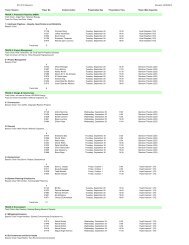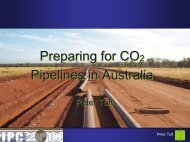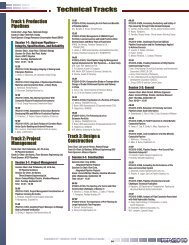Download Presentation (pdf) - International Pipeline Conference 2012
Download Presentation (pdf) - International Pipeline Conference 2012
Download Presentation (pdf) - International Pipeline Conference 2012
You also want an ePaper? Increase the reach of your titles
YUMPU automatically turns print PDFs into web optimized ePapers that Google loves.
Carbon Capture and<br />
Storage<br />
IPC2: Panel on CO 2 <strong>Pipeline</strong>s<br />
http://www.ico2n.com<br />
September 2010
ICO 2 N: Who We Are<br />
16 leading companies from a variety of industries<br />
TransAlta Corporation<br />
BP<br />
ConocoPhillips Company<br />
Total E&P Canada Ltd.<br />
Imperial Oil Ltd.<br />
Nexen Inc.<br />
Statoil Canada Ltd.<br />
Syncrude Canada Ltd.<br />
Air Products Canada Inc.<br />
Canadian Natural Resources Ltd.<br />
Devon Energy<br />
Husky Energy Inc.<br />
Keyera<br />
Shell Canada Energy<br />
Suncor Energy Inc.<br />
Enbridge <strong>Pipeline</strong>s<br />
2
ICO 2 N Mandate<br />
The ICO 2<br />
N Group addresses challenges and solutions to how largescale<br />
CCS can be accelerated in Canada<br />
Through policy development work, CCS technical studies, input on the<br />
formation of CCS regulations and stakeholder engagement, ICO 2<br />
N will<br />
provide industry’s guidance to how CCS can be implemented efficiently<br />
during the next decade<br />
Leading CSC technical work, economic analysis and policy<br />
input since 2005<br />
3
Surface Facility Safety Study: Objectives<br />
‣ ICO 2 N recognized an opportunity to undertake a theoretical<br />
assessment of CO 2 hazard issues in advance of CCS project<br />
deployment<br />
‣ Golder Associates was commissioned to evaluate risks associated<br />
with accidental releases of CO 2 from surface facilities<br />
• Model releases based on ICO 2 N conceptual pipeline system in Alberta<br />
• Public risk estimated in terms of hazard distance probabilities<br />
‣ Increase understanding of consequences of release scenarios of<br />
CO 2 as pressurized, non-flammable fluid undergoing rapid phase<br />
change
Release Characteristics<br />
‣ Rapid decay of release rate<br />
‣ Initial release governs hazard distance<br />
Rupture Scenarios
CO 2 Hazard Footprint – D5
Ambient Conditions and Releases<br />
F-1.5 Rupture Maximum Hazard<br />
Distance Radius<br />
Meteorological Stability Class ‐ Wind Speed (m/s)<br />
Trunkline Rupture Scenario<br />
F‐1.5 D‐5 D‐10<br />
Hazard Distance Frequency (km‐yr) 6E‐06 4E‐06 4E‐07<br />
Leak Maximum Hazard<br />
Distance Radius<br />
Maximum arc of ground plume 20%<br />
Trunk Line Leak Scenario<br />
Meteorological Stability Class ‐ Wind Speed (m/s)<br />
F‐1.5 D‐5 D‐10<br />
Hazard Distance Frequency(km‐yr) 3E‐05
Summary and Conclusions<br />
‣ CO 2 transmission systems designed, built and<br />
maintained to existing standards should result in long<br />
term accidental failure frequencies comparable to natural<br />
gas pipeline industry record<br />
‣ Ruptures cause larger hazard zones than leaks<br />
‣ The frequency of leaks is greater than ruptures<br />
‣ Initial release governs hazard distance<br />
‣ Hazard distances increase with pipe diameter<br />
‣ Presence of H 2 S or SO 2 in very small concentrations can<br />
drive hazard distances
Alberta CO 2 Purity Project<br />
‣Q4 2009: Alberta government narrows RFP list to 4 projects<br />
• Includes contribution from Ottawa<br />
• Scheduled to be underway in 2015 timeframe<br />
‣Industry work is underway<br />
• capture design, pipeline design & engineering<br />
• sequestration / EOR opportunities<br />
• this work is not informed by purity standards<br />
‣ Regulatory policy and governance being formed<br />
• Industry needs to provide a common message to regulators and government
Alberta CO 2 Purity Project<br />
Broad range of CCS industry expertise
Project Details<br />
FUNDING<br />
‣ Participation:<br />
• Industry : $ 7,500<br />
• Industry Consortium: $30,000<br />
‣ ~ $250 CAD raised from industry to date<br />
‣ Government funding being actively sought<br />
‣ High leverage on participants’ funding dollars:<br />
• > 25:1 on committed industry funding alone<br />
TIMELINE<br />
‣ August 2010 kickoff<br />
‣ Early work underway<br />
‣ Estimate 15 month duration<br />
Funding in one component<br />
provides access to General<br />
Information from all other<br />
components, participation in<br />
periodic review sessions,<br />
and access to the Final<br />
Report
An Evolution of the CCS Dialogue<br />
Focused years leading to 2015<br />
Early years: 2005 - 2009<br />
Getting CCS on the Agenda<br />
• Internal analysis of CCS deployment<br />
- Technology<br />
- Economics<br />
- Policy<br />
• Basic CCS education and advocacy<br />
• Advocacy on the scale of the potential<br />
reduction<br />
• Size of the initial financial gap facing firstmover<br />
projects<br />
Focusing on CCS Deployment<br />
• Support for 4 Alberta RFP Projects for 2015:<br />
- Specific technical studies<br />
- Policy framing<br />
- Support the regulatory process (Alberta Energy<br />
RFA)<br />
• Scope a broadly defined risk assessment to<br />
address safety and stakeholder concerns<br />
• Focus on long-term, large-scale deployment<br />
- Integrated system approach<br />
Post 2015<br />
CCS Learnings and Next Phases<br />
• Adopt critical learnings from existing projects<br />
• Continued advocacy on broadened incentives for<br />
next phase of projects<br />
• Long-term, large-scale deployment and an<br />
Integrated system approach<br />
12
Alberta’s CCS Projects<br />
Quest Project Project Pioneer Alberta Carbon<br />
Trunk Line<br />
Swan Hills<br />
Synfuels<br />
Project<br />
Lead<br />
Host<br />
Facility<br />
Shell Canada on<br />
behalf of the<br />
Athabasca Oil<br />
Sands Project<br />
Shell Scotford<br />
Oil Sands<br />
Upgrader<br />
<strong>Pipeline</strong> 12 to 16 inch, 100<br />
km<br />
TransAlta Enhance Energy Swan Hills<br />
Synfuels /<br />
Sagitawah Power<br />
Keephills 3<br />
(new 450 MW<br />
supercritical coal<br />
~8 inch, 20 km &<br />
70 km<br />
Agrium SMRs<br />
(existing)<br />
Northwest<br />
Upgrader<br />
SHS Underground<br />
Coal Gasification<br />
16 inch, 220 km ~ 8 inch, 20 km<br />
Sequestrati<br />
on<br />
CCS<br />
Volume<br />
Estimated<br />
Project<br />
Cost<br />
Deep Saline<br />
Formation;<br />
Potential future<br />
EOR<br />
Deep Saline<br />
Formation;<br />
Potential EOR<br />
$1.35 Billion ~1.1 to 1.2<br />
Billion<br />
EOR;<br />
Potential future<br />
Depleted O&G<br />
fields<br />
~0.70 to 0.75<br />
Billion<br />
EOR<br />
1.2 Mtpa 1.0 Mtpa 1.9 Mtpa 1.3 Mtpa<br />
~0.40 to 0.45<br />
Billion<br />
Sept 2010
14<br />
Synergies with Alberta RFP Projects
Initial Integration Observations<br />
Good Overall Geographic Alignment<br />
• Shell, TransAlta and Enhance pipeline plans can form the initial<br />
stages of an integrated system<br />
• Results in some upsizing, realignment and removes the need<br />
for some infrastructure<br />
Some Design Concerns:<br />
• Enhance pressure regime not consistent<br />
• Volumes in Red Deer area may exceed capabilities<br />
15
ICO 2 N’s Long-term Vision<br />
Alberta CCS Development<br />
Council articulated the need<br />
for infrastructure preplanning:<br />
“safe, orderly, and environmentally<br />
appropriate construction of capture,<br />
transportation and injection facilities”<br />
“initial CO 2<br />
pipelines, where possible,<br />
are designed so they can be<br />
incorporated into an efficient<br />
provincial network”<br />
“must address liability, safety, CCS<br />
governance and pipeline<br />
infrastructure development options<br />
and approaches”<br />
16
Essential Elements of a CCS Network<br />
1. Cost efficient design<br />
• Routing optimized for longer term source/sink matching<br />
• Sizing for future volumes at modest incremental cost<br />
2. Safety is enhanced through minimized infrastructure<br />
• Surface facilities<br />
• Sequestration locations<br />
3. Set the stage for greater stakeholder confidence<br />
4. Multiple CO 2<br />
sources and EOR/storage locations<br />
• Allows for operational efficiency when a capture or storage facility is unavailable<br />
• Allows standardization<br />
5. Minimize environmental footprint<br />
6. Open access / common carrier<br />
• Need to ensure access and fair toll pricing for all shippers<br />
17






